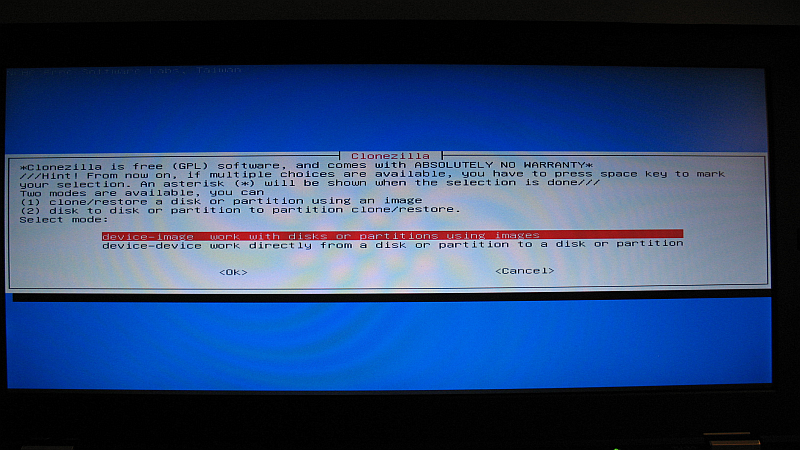Clonezilla Windows 10 Support
Hi there,
Clonezilla has the following characteristics: open source program for free a image of a hard drive, free alternative to Norton Ghost and Symantec Ghost Corporate Edition, available in two editions, Clonezilla SE (Server Edition) and Clonezilla Live, suitable for MS Windows, Mac OS and Linux. Clonezilla screenshots. If you’re running Windows 10 on your device, you can also use Clonezilla to migrate the current installation with all your settings, apps, and files to a new larger or faster drive without the need of reinstalling the operating system. Or you can use Clonezilla as a backup tool before making changes to your current installation. This tutorial represents a practical excerpt on how to migrate (also known as cloning) a Windows 10 Operating System from a large HDD with multiple partitions, such as C:, D:, to a smaller SSD using a Linux distribution which includes Clonezilla utility. Clonezilla utility can run from PartedMagic. Clonezilla is a great free disk cloning and imaging tool which help you do system migration, bare metal backup and recovery in Windows 7/8/10. However, there are some limitations. Is there any alternative to Clonezilla?
I've been using Clonezilla to make snapshots of my Windows installs for years now, and never had a problem rolling back / restoring. However, I recently upgraded to Windows 10. I've got two other drives in my computer, D: & F:, to hold data. I made a bunch of changes to the files in D: & F:, then decided to restore the first Windows 10 image I made. When I did, the contents of D: & F: looked exactly like they did when I made the image! This caused all sorts of problems as you might imagine; unable to open files (didn't exist), or sometimes able to open files that used to exist but I deleted insecurely, or incorrect owner information and I had to provide admin credentials to take the files back.
I wiped both partitions and put dummy files in to test, just text files and folders. I'd make an image of my Windows 10 install (on C: only) with Clonezilla. Then I would modify the files, restore the image, and check the contents of D: and F: afterwards. Restoring Windows 10 would consistently return the dummy files to what it looked like when I made the image, not what it looked like after I made changes.
To make things more interesting, I immediately restored to a Windows 8 image I had, and the dummy files showed up correctly modified! I found out that if I went into Disk Management after restoring Windows 10, unmapped the drives from their letters, then remapped them, the correct files would appear. However, sometimes they are corrupted (incorrect owner like above, had to take ownership by admin creds, etc). Although the dirty flag wasn't set on the drives, if I did a chkdsk, both drives had numerous errors that had to be fixed from Windows 10's perspective.
I've never seen this behavior before until Windows 10. Does anybody have any idea what's going on? Is there some new feature that's caching attached file systems, or a change to how NTFS in Windows 10 that I didn't hear about? Would really appreciate any help, as I've relied on Clonezilla for at least 7 years now, but I can't continue to use it for fear it will corrupt all the files I have on attached drives. Already happened today, and I lost a lot of data that should have been backed up on a separate system.

As a test for using Clonezilla with Windows 10, I built a Windows 10 machine, and booted to the Clonezilla Live-CD to create an image across the network on our file server.
I cloned the entire drive, not partitions.

I then rebooted to the Clonezilla Live-CD and restored the image to the original machine. However, the system will not boot.
When I try to boot from the cloned HDD, it immediately goes to the Preparing Automatic Repair, then Diagnosing your PC, then attempting repairs and then fails - giving me the options to ...
Exit and continue to Windows, which simply repeats the steps.Troubleshooting, where I tried the recovery again with no success.Power off

I have also tried rebooting to Windows 10 Install CD, and tried all the automatic recovery steps, as well as the following from the Troubleshooting | Command line ...
NOTE: That the bootrec.exe /scanos reported that no Windows OS were found.
However, using an Ubuntu 18 live cd, I confirmed that the hard drive is OK, and all the NTFS partitions successfully mount and read.
Can this be fixed by ...
1. A different way to copy the Clonezilla image to the local hard drive?
2. Fix the current local hard drive (cloned from the image)?
@yagmoth555
Clonezilla Windows 10 Support Update
I'm not sure how to make the correct edits. I'm assuming I need to edit the Boot Loader (not the Boot manager). But searching the web has not clarified it for me.
Do you know the bcdedit command to change the correct partition.
The boot partition is (I believe) partition 1, 500mb (which should be C:).
1 Answer
My guess is that the boot manager is using a target partition for Windows that is now unable to find, like C:, but while on the cloned image the layout is maybe modified, and it can be on like D:
I would try to locate the Windows 10 partition while loaded with the Windows 10 install media to be sure it match the boot manager.
To do so; Run diskpart, select disk X, list partition from the target machine and the original's machine to compare.
In the target system run bcdedit, and note the disk partition. partition=C, etc.. and do a bcdedit /edit to change the letter to fit the one on the target machine.
yagmoth555♦yagmoth555